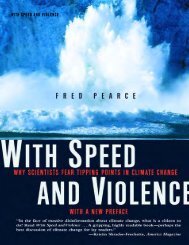A better world is possible - Global Commons Institute
A better world is possible - Global Commons Institute
A better world is possible - Global Commons Institute
You also want an ePaper? Increase the reach of your titles
YUMPU automatically turns print PDFs into web optimized ePapers that Google loves.
Copyright Bruce Nixon 2010. All rights reserved. Th<strong>is</strong> electronic copy <strong>is</strong> provided free for personal, non-commercial use only.<br />
www.brucenixon.com<br />
2020 from 2006 levels. It argues that current government policies, including intensive improvements to<br />
vehicle efficiency, will achieve less than a 5% reduction in CO 2 on 1990 levels by 2020. The Campaign’s<br />
proposals, in line with overall aims to achieve 80% reduction in em<strong>is</strong>sions by 2050, are:<br />
Cut overall CO2 em<strong>is</strong>sions from transport by 26% by 2020 on 2006 figures.<br />
Cut passenger travel em<strong>is</strong>sions by 32%.<br />
Cut freight em<strong>is</strong>sions by up to 19%.<br />
Make cars 25% more fuel efficient.<br />
Cut car traffic by 15%; and<br />
Cut domestic aviation em<strong>is</strong>sions by 30%.<br />
It recommends policies ranging from increasing walking to reducing aviation and deep sea shipping. They<br />
vary in impact but are mutually supportive and need to be implemented as a package.<br />
Vehicle technology and low-carbon fuels UK have about 27 million private cars, with a refresh rate of about<br />
15 years. Policies to encourage technological change in the vehicle fleet include:<br />
<br />
<br />
<br />
<br />
<br />
<br />
<br />
<br />
First year charges on cars related to their level of em<strong>is</strong>sions, to increase annually to 2020 and<br />
applied per gram above an efficiency reference level, at least 130 in 2012, 100 in 2015 and 90 by<br />
2020.<br />
Efficiency reference level to r<strong>is</strong>e annually as technology becomes available so the charge on less<br />
efficient vehicles r<strong>is</strong>es in real terms.<br />
Air conditioning and other power consuming devices to be included in carbon em<strong>is</strong>sion g/km (grams<br />
per kilogram) calculations.<br />
Vans brought within car standards scheme.<br />
Fuel duty to r<strong>is</strong>e in line with predicted improvements in efficiency to avoid rebound effect.<br />
Vehicle Exc<strong>is</strong>e Duty increases to be slowed down as the least effective means of changing purchasing<br />
behaviour.<br />
Reduce work-related car travel. Work-related travel accounts for 37% of total CO 2 em<strong>is</strong>sions from<br />
passenger transport: 24% from commuting and 13% from travel in the course of business. People are<br />
taking long journeys by themselves: 91% of car commuting and 87% of business car trips.<br />
Tax changes are recommended for business use of private cars to reward low-carbon vehicles and<br />
reduce incentives for high business mileage; active traffic management systems to make longer road<br />
journeys more efficient; tax breaks to promote cash back and green bonus schemes that reward<br />
people for not driving to work; government serving as an example for supporting low-carbon<br />
commuting and business travel.<br />
Similar actions are needed to reduce shopping related travel.<br />
Reduce journey lengths and transfer short car journeys to walking and cycling. Between 1985 and 2005<br />
average annual mileage per head within UK increased by 35%.Th<strong>is</strong> <strong>is</strong> the result of the interaction of transport<br />
policies with land use planning. Car journeys of less than five miles account for 20% of passenger transport<br />
CO2. Shifting some of these to walking and cycling will help cut congestion and obesity and improve health<br />
too.<br />
Land use policy <strong>is</strong> a key component. The market for land, and dec<strong>is</strong>ions about how it <strong>is</strong> used, depend<br />
crucially on transport. Th<strong>is</strong> <strong>is</strong> a two way relationship—transport demand ar<strong>is</strong>es from land use and land use<br />
114
















